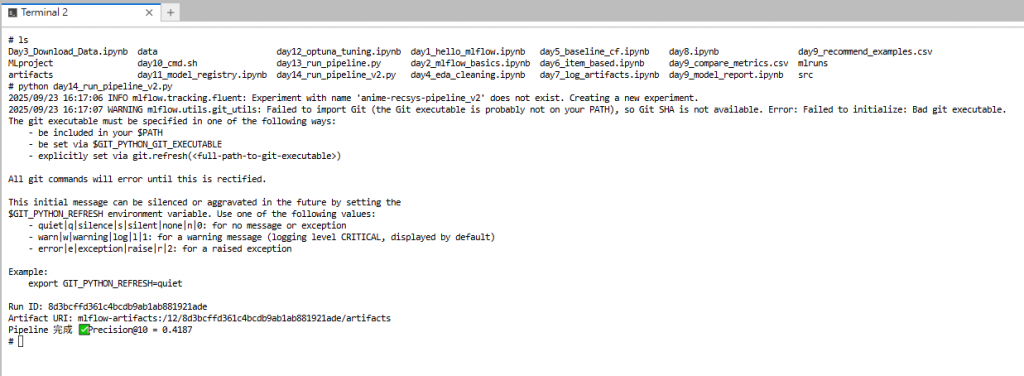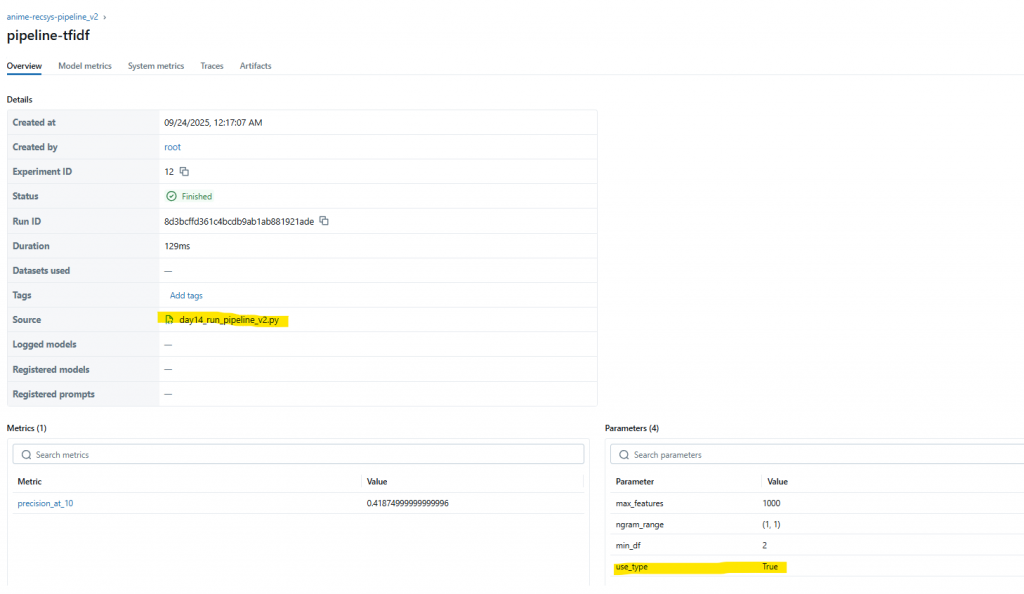在 Day 13,我們已經建立了 Pipeline,可以一鍵執行「載入資料 → 訓練 TF-IDF → 評估並記錄到 MLflow」。
不過,目前我們的模型只使用了 genre 欄位作為特徵。
👉 如果加入更多特徵,例如動畫的 type(TV、Movie、OVA…),能讓向量化結果更豐富,推薦也更合理。
今天的任務是:
use_type=True/False 的結果。今天我們會修改兩個檔案:
/usr/mlflow/src/pipeline/pipeline.py # 修改 train_model,加入 use_type 特徵
/usr/mlflow/run_pipeline.py # 主程式,設定 use_type=True/False
📂 路徑:/usr/mlflow/src/pipeline/pipeline_v2.py
import os
import pandas as pd
import numpy as np
from sklearn.feature_extraction.text import TfidfVectorizer
from sklearn.metrics.pairwise import cosine_similarity
import mlflow
DATA_DIR = "/usr/mlflow/data"
class AnimePipeline:
def __init__(self, sample_size=1000):
self.sample_size = sample_size
def load_data(self):
"""載入動畫資料,只取部分樣本確保 3 分鐘內可跑完"""
anime = pd.read_csv(os.path.join(DATA_DIR, "anime_clean.csv"))
ratings_train = pd.read_csv(os.path.join(DATA_DIR, "ratings_train.csv"))
# 抽樣,避免跑全量太久
anime = anime.sample(self.sample_size, random_state=42).reset_index(drop=True)
return anime, ratings_train
def train_model(self, anime, max_features=1000, ngram_range=(1,1), min_df=2, use_type=True):
"""用 TF-IDF 訓練 item-based 模型,可以選擇是否加入 type 特徵"""
# ✅ 拼接 genre + type 作為新的特徵
if use_type:
anime["features"] = anime["genre"].fillna("") + " " + anime["type"].fillna("")
else:
anime["features"] = anime["genre"].fillna("")
vectorizer = TfidfVectorizer(
stop_words="english",
max_features=max_features,
ngram_range=ngram_range,
min_df=min_df
)
tfidf = vectorizer.fit_transform(anime["features"])
sim_matrix = cosine_similarity(tfidf)
return sim_matrix
def evaluate_and_log(self, anime, sim_matrix, params):
"""簡單評估 Precision@10 並 log 到 MLflow"""
def precision_at_k(recommended, relevant, k=10):
return len(set(recommended[:k]) & set(relevant)) / k
# ✅ 抽樣 30 部動畫做測試,加快速度
test_idx = np.random.choice(len(anime), 30, replace=False)
scores = []
for idx in test_idx:
sim_scores = list(enumerate(sim_matrix[idx]))
sim_scores = sorted(sim_scores, key=lambda x: x[1], reverse=True)
top_idx = [i for i, _ in sim_scores[1:11]]
recommended = anime.iloc[top_idx]["name"].tolist()
relevant = anime[anime["genre"] == anime.iloc[idx]["genre"]]["name"].tolist()
if len(relevant) > 1:
scores.append(precision_at_k(recommended, relevant, k=10))
avg_precision = np.mean(scores)
# 👉 mlflow.start_run(): 開始一個新的實驗 run
with mlflow.start_run(run_name="pipeline-tfidf") as run:
mlflow.log_params(params) # 記錄參數
mlflow.log_metric("precision_at_10", avg_precision) # 記錄指標
print("Run ID:", run.info.run_id)
print("Artifact URI:", run.info.artifact_uri)
return avg_precision
📂 路徑:/usr/mlflow/day14_run_pipeline_v2.py
import mlflow
from src.pipeline.pipeline_v2 import AnimePipeline
# 👉 mlflow.set_tracking_uri(): 指定要連線的 MLflow Tracking Server
mlflow.set_tracking_uri("http://mlflow:5000")
# 👉 mlflow.set_experiment(): 指定實驗名稱,若不存在會自動建立
mlflow.set_experiment("anime-recsys-pipeline_v2")
def main():
pipeline = AnimePipeline(sample_size=1000)
anime, ratings_train = pipeline.load_data()
# ✅ 可以調整 use_type=True/False,比較兩種特徵的差異
params = {
"max_features": 1000,
"ngram_range": (1,1),
"min_df": 2,
"use_type": True
}
sim_matrix = pipeline.train_model(anime, **params)
score = pipeline.evaluate_and_log(anime, sim_matrix, params)
print(f"Pipeline 完成 ✅ Precision@10 = {score:.4f}")
if __name__ == "__main__":
main()
在 python-dev 容器內執行:
python day14_run_pipeline_v2.py
執行結果:
MLflow UI → Experiments → anime-recsys-pipeline 裡會看到:
use_type=True 的 runuse_type=False,就能比較兩種特徵的效果差異。

mlflow.log_params(params)max_features, ngram_range, use_type)。mlflow.log_metric("key", value)anime_clean.csv
│
▼
[ genre (+ type) 特徵拼接 ]
│
▼
TF-IDF → Cosine Similarity → Precision@10
│
▼
MLflow Tracking (params + metrics)
今天我們在 Pipeline 裡新增了 use_type 參數:
use_type=False → 只用 genreuse_type=True → genre + type透過 MLflow,我們能直接比較兩個 run 的 Precision@10,分析是否有幫助。
整個流程只抽樣 1000 筆動畫 + 測試 30 筆,保證 3 分鐘內完成。
👉 下一步(Day 15),我們會統一不同模型的推論格式,並把推薦結果存成 Artifacts,方便後續比對與部署。
